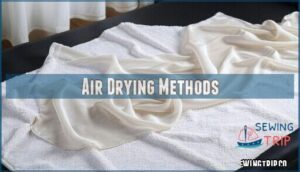This site is supported by our readers. We may earn a commission, at no cost to you, if you purchase through links.

Raw silk shrinks more than pre-treated varieties.
You can deliberately shrink oversized silk garments using hot water (140°F+), gentle agitation, and controlled heat.
For prevention, stick to cold water and gentle handling.
The protein fibers contract when exposed to moisture and heat, making shrinkage predictable.
Hot water accelerates the process, while cold water minimizes it.
Machine washing on delicate cycles with mild detergent works, but hand washing gives you better control.
Air drying preserves size better than heat drying.
Understanding these basics lets you either prevent unwanted shrinkage or intentionally resize garments that are too large.
Table Of Contents
Key Takeaways
- You can control silk shrinkage by choosing your water temperature – hot water (140°F+) causes 8-20% shrinkage, while cold water minimizes it to under 3%.
- Hand washing gives you better control than machine washing – use lukewarm water, silk-specific detergents, and gentle agitation to prevent unwanted shrinkage.
- You can intentionally shrink oversized silk garments – use controlled hot water immersion, gentle agitation, and strategic heat application to achieve the perfect fit.
- Once silk shrinks, you cannot reverse it – the protein fibers permanently contract, so prevention through proper care is your best strategy.
Silk Shrinkage Basics
Before you start washing your silk items, you’ll want to understand what makes this luxurious fabric so special and why it behaves differently than cotton or polyester.
Silk’s unique protein structure and delicate fibers require specific care techniques to maintain their beauty and prevent unwanted shrinkage.
What is Silk Fabric
Silk fabric comes from silkworms’ cocoons, creating one of nature’s strongest and most luxurious materials.
You’ll find this protein-based fiber has unique properties that make it both delicate and durable, requiring special care to maintain its lustrous appearance and smooth texture.
- Natural protein fibers create silk’s distinctive strength and elasticity compared to plant-based materials
- Mulberry silk represents the highest quality grade, produced by domesticated silkworms fed exclusively on mulberry leaves
- Wild silk varieties like tussah offer different textures and colors but generally provide less uniformity
- Fiber structure consists of two main proteins (fibroin and sericin) that determine silk’s sheen and drape
- Historical significance spans over 5,000 years, with silk production originating in ancient China before spreading worldwide
Types of Silk Fabrics
Different silk fabric types respond uniquely to water exposure.
Charmeuse fabric’s satin weave makes it particularly vulnerable to silk shrinkage, while Dupioni silk’s irregular texture offers more resistance.
Habotai weave provides moderate protection during washing silk.
Silk blends with synthetic fibers shrink less than pure silk clothes.
Velvet textures require extra caution since their pile structure amplifies shrinkage effects, making proper silk care absolutely critical.
Silk Care and Maintenance
Since proper silk care determines whether your garments maintain their lustrous beauty or become expensive rags, understanding textile science becomes essential.
Silk care requires gentle handling—hand washing prevents silk shrinkage better than machines.
Store silk garments in breathable cotton bags for ideal silk storage. Avoid fabric softening products that damage fibers.
Color preservation depends on cold water washing and avoiding direct sunlight. Silk blending affects care requirements substantially.
Does Silk Shrink When Washed
The short answer is yes – silk fabric does shrink when washed, but the extent depends on several factors.
Most silk blends and pure silk garments will experience some degree of shrinkage, typically ranging from 3-8% in length and width.
Shrinkage tests reveal that washing methods substantially impact results.
Hot water causes dramatic shrinkage, while cold water minimizes it.
Machine washing with regular agitation creates more shrinkage than gentle hand washing.
Different silk types react differently – raw silk shrinks more than processed varieties, and silk blends behave according to their fiber composition.
The good news? You can control silk shrinkage with proper washing techniques.
Cold water, gentle detergents, and minimal agitation help prevent unwanted shrinkage.
However, if you’re looking to shrink silk clothes intentionally, controlled hot water washing and fabric softening treatments can achieve desired results.
Understanding these silk care tips helps you maintain your garments’ original size or shrink them purposefully when needed.
Why Silk Shrinks in Water
Understanding why silk shrinks when you wash it starts with the fiber’s unique protein structure.
When silk protein fibers get wet, they relax and contract naturally, causing the fabric to pull together and become smaller, which is a natural process.
Hot Water Effects
Hot water acts like a shrinking machine for silk fibers, causing protein molecules to contract and tighten the fabric weave.
When you expose silk to temperatures above 86°F during a hot wash, you’ll see shrink rates jump to 10-15% compared to cold water’s gentler 3%.
This fabric damage happens because heat weakens the delicate structure, making silk shrinkage nearly irreversible—definitely not your silk washing goal!
To minimize damage, this is key: follow proper silk care tips when washing and drying silk fabrics, which is the proper way to handle silk to prevent irreversible damage and achieve your silk washing goal.
Cold Water Effects
Cold water washing offers better shrinkage control for silk fabric compared to hot water.
While silk can still shrink slightly in cold water due to fiber swelling, you’ll typically see under 3% shrinkage with gentle washing techniques.
The key is avoiding agitation and using silk-specific detergents. Your water temperature choice makes all the difference in preventing silk shrinkage during washing silk clothes.
Understanding the silk shrinkage process is essential for achieving the desired fit and maintaining the fabric’s quality with gentle washing techniques.
Different Weaves and Shrinkage
Different silk fabric types behave uniquely when exposed to water.
Loosely woven silk garments like chiffon typically shrink 8-10%, while tightly woven silk material with higher thread counts shrinks only 3-5%.
Fabric density directly affects shrinkage rates – think of loose weave patterns as having more room to contract compared to dense weaves that resist movement, which is related to the concept of fabric density.
How to Prevent Silk Shrinkage
You can protect your silk garments from shrinkage by using cool water, gentle detergents, and proper drying techniques.
The key is avoiding heat and aggressive agitation that breaks down silk’s delicate protein fibers.
Hand Washing Techniques
Hand washing silk correctly prevents shrinkage while maintaining fabric quality.
You’ll need lukewarm water (up to 77°F) and silk-specific detergents for gentle cleansing without fiber damage.
Follow these hand washing essentials:
- Silk soaking: Limit to 3-5 minutes in cold water to prevent dye bleeding
- Soap selection: Use pH-neutral detergents like Woolite Delicates or baby shampoo
- Gentle agitation: Swirl softly, never wring or twist wet silk fibers
These silk washing tips guarantee your silk laundry stays pristine.
For the best results, always check the silk care guide to understand the specific needs of your silk items.
Machine Washing Precautions
While hand washing offers maximum control, you can machine wash silk safely with proper precautions.
Use delicate settings and gentle detergents to prevent silk shrinkage. Select the lowest spin speed available, as high-speed agitation causes silk laundry disasters.
Skip fabric softener entirely—it coats silk fibers and reduces their natural luster. Choose wash cycles specifically designed for delicate fabrics, and remember: when in doubt, don’t shrink silk accidentally.
To minimize risks, consider the importance of preventing fabric shrinkage when washing silk garments.
Drying and Ironing Methods
Two critical steps protect your silk from shrinkage damage.
Air drying works best—lay garments flat on clean towels, avoiding direct sunlight that’ll fade colors.
For wrinkle removal, use a steamer or iron on low heat with a pressing cloth.
Never wring wet silk; instead, gently squeeze excess water.
Proper drying and ironing techniques keep your silk fabric care routine foolproof and ensure it remains in good condition by using the right methods, such as low heat.
Washing Silk in Machines
Machine washing silk doesn’t have to be a fabric disaster if you know the right approach.
Master silk care with the right techniques—your delicate fabrics deserve expert handling, not guesswork.
You’ll need to master three critical elements: selecting the delicate cycle, choosing silk-safe detergents, and minimizing mechanical stress that causes shrinkage.
Delicate Cycle Settings
When machine washing silk, selecting the proper Delicate Mode becomes your fabric’s lifeline.
Most washing machines offer Silk Settings or Gentle Wash cycles that limit agitation and use Cold Soak temperatures below 30°C.
These specialized cycles prevent silk shrinkage through reduced mechanical stress.
Choose the shortest spin cycle available—excessive spinning stretches fibers and causes permanent damage.
Your silk washing guide should prioritize fabric care over convenience, ensuring that you use the correct method to prevent damage, such as permanent damage.
Choosing Gentle Detergents
Regular laundry detergent contains harsh chemicals that’ll damage silk fibers and cause shrinking.
Choose mild soaps or specialized silk detergents instead—they’re gentler on delicate fabrics.
Avoid fabric softeners completely, as they leave residue that breaks down silk’s natural proteins.
Woolite and similar gentle cleansers work well as soap alternatives for your silk washing guide.
When selecting a detergent, consider the importance of using a silk detergent to preserve the quality of your silk items.
Avoiding Agitation and Spin
Machine agitation can turn your silk into a crumpled mess faster than you can say "oops." The secret lies in minimizing movement and eliminating the spin cycle entirely.
Here’s your silk protection playbook:
- Select delicate or hand-wash cycle for minimal agitation control
- Disable spin cycle completely to prevent fabric stress
- Use mesh laundry bags for extra silk protection during gentle washing
- Add extra water to reduce fabric-to-fabric friction
- Choose shortest wash time to limit exposure to agitation
This fabric softening approach prevents the mechanical stress that causes silk shrinkage guide disasters, keeping your delicate items intact.
Drying and Ironing Silk
After you’ve washed your silk properly, how you dry and iron it determines whether it shrinks or maintains its luxurious feel.
The key is gentle handling during these final steps – rush the process with high heat, and you’ll end up with a disappointingly small, stiff garment that barely resembles its former glory.
Air Drying Methods
After washing silk, lay it flat on a clean towel away from direct sunlight.
Reshape gently while damp to prevent fabric stretching. Good air circulation helps silk dry evenly without shrinkage.
Roll in a towel first to remove excess water, then use gentle folding techniques. These air drying methods preserve silk’s natural texture and prevent the harsh shrinking that heat causes, which is crucial for maintaining the silk’s quality and preventing shrinkage.
Tumble Dryer Precautions
While air drying protects silk best, you might wonder about using your dryer.
Heat Control becomes critical – high temperatures cause rapid shrinking silk clothes and damage delicate fibers.
Set dryer to no-heat or air-only settings if you must use it. Remove silk items while slightly damp to prevent overdrying.
Consider Fabric Protection by using dryer balls to reduce friction. For Silk Safety, hand-checking every few minutes prevents disaster.
Using silk dryer balls can help reduce wear and tear on silk fabrics during the drying process, ensuring Heat Control and promoting silk care.
Ironing and Steaming Techniques
Once your silk is properly dried, proper ironing and steaming techniques will prevent additional shrinkage while removing wrinkles.
Heat pressing requires careful temperature control to avoid damaging delicate silk fibers.
Silk ironing and steaming essentials:
- Set iron to silk setting – Use lowest heat with steam function for gentle wrinkle removal
- Press cloth barrier – Place thin cotton between iron and silk for fabric shrinkage prevention
- Steam vertically – Hold garment taut while steaming to smooth without direct contact
Shrinking Silk Clothes Easily
Sometimes you need to intentionally shrink silk garments to achieve the perfect fit.
While silk naturally resists shrinkage, you can use controlled methods like hot water immersion, gentle agitation, and strategic heat application to reduce the fabric’s dimensions without damaging its luxurious texture.
Controlled Shrinkage Methods
Perfect timing—you’ve moved beyond basic care to actually reshaping your silk pieces.
Controlled shrinkage methods give you surgical precision over fabric relaxation and textile manipulation.
Steam shrinking delivers 5-10% size reduction with gentle, even results.
Heat shrinking using an iron at 250-300°F achieves 8-15% shrinkage for thicker weaves.
Multiple gentle rounds with cooling intervals prevent fiber damage while maintaining shrinkage control throughout your delicate fabric care process, ensuring gentle results.
Using Hot Water for Shrinkage
When you want to shrink silk fabric, hot water becomes your primary tool for controlled shrinkage.
Water temperature above 85°F starts breaking down silk fibers, causing them to contract predictably.
Here’s how to use hot water for silk shrinkage:
- Fill a basin with water between 100-120°F – this temperature range provides moderate shrinkage without damaging fibers completely
- Submerge the silk garment for 15-30 minutes – longer exposure increases shrinkage but risks weakening the fabric structure
- Monitor water temperature throughout the process – cool water reduces effectiveness, while overheated water can cause uneven shrinkage
- Test shrinkage on a hidden area first – different silk weaves react differently to hot water treatment
- Remove and gently squeeze out excess water – avoid wringing or twisting which can create permanent creases or tears
Hot water effects work best on natural silk fabrics rather than silk blends.
The key to successful fabric treatment lies in maintaining consistent water temperature and timing your fabric shrinkage solutions carefully.
Agitation and Friction Techniques
Beyond hot water, physical agitation accelerates silk shrinking through fabric stress and friction methods.
You’ll create controlled shrinkage by gently rubbing the wet silk between your hands or using soft abrasion techniques. This isn’t gentle washing—you’re deliberately applying fabric stress to compress fibers.
Monitor agitation control carefully, as excessive friction can damage delicate silk threads permanently.
Understanding the silk fabric properties is essential to achieve the desired shrinkage without causing damage, and to apply the right amount of friction.
Caring for Shrunk Silk Clothes
When your silk garments have shrunk, don’t panic—you can often restore them to their former glory with the right techniques.
Taking immediate action and using proper care methods will help you salvage your favorite silk pieces and prevent additional damage.
Repairing and Altering Shrunk Silk
Restoration becomes possible when shrunk silk garments need textile revival.
Try fusible interfacing for tears—cut patches one inch larger than damage and apply with low heat.
Use silk thread for invisible repairs, sourcing fabric from hidden garment areas.
Fabric alteration through side panels or gussets can restore fit when shrinkage fix attempts fail completely, requiring a more invasive restoration approach.
Preventing Further Shrinkage
Once silk shrinks, stabilizing the fabric becomes vital to prevent additional damage.
Always switch to gentle cleaning methods using lukewarm water and specialized silk detergents.
Avoid aggressive agitation, high heat, and harsh chemicals that compromise textile preservation.
Store garments properly with fabric stabilizers, and handle delicate fabrics with extra care during future washing cycles.
To minimize shrinkage, following proper fabric care tips when washing silk garments is key.
Restoring Silk Texture and Shine
Life-saving silk refinishing tricks can revive your shrunken treasures.
Mix one tablespoon white vinegar with lukewarm water, then gently work the solution through fabric fibers.
For shine enhancement, apply a light mist of distilled water while ironing on low heat.
These texture restoration methods preserve color while bringing back silk’s natural luster through proper fabric care techniques.
Frequently Asked Questions (FAQs)
How to shrink 100% silk?
Like ye olde laundresses knew, you can’t actually shrink 100% silk easily since it’s already pre-shrunk during manufacturing.
Hot water and high heat will damage the fibers rather than shrinking them uniformly.
Does 100% silk shrink in the dryer?
Yes, 100% silk does shrink in the dryer.
High heat breaks down silk fibers, causing significant shrinkage and potential damage.
You’ll get better results using low heat settings, but air-drying remains the safest option for preserving your silk’s quality.
How to reverse silk shrinkage?
Wondering if you can undo the damage?
Unfortunately, you can’t truly reverse silk shrinkage once it’s happened.
The protein fibers permanently contract during washing or drying, making restoration impossible through stretching or steaming methods.
Can you shrink silk in a washing machine?
Yes, you can shrink silk in a washing machine, but it’s risky.
Use hot water and high heat settings, though this may damage the fabric permanently.
Hand-washing with hot water offers more control over the shrinking process, and is a safer alternative to machine washing for delicate fabrics like silk.
Can silk shrink after professional dry cleaning?
Professional dry cleaning typically doesn’t shrink silk since it uses chemical solvents instead of water.
However, improper heat application during pressing or steaming can cause minimal shrinkage, usually less than 3-5%.
Does mulberry silk shrink differently than other types?
Mulberry silk’s magnificent molecular structure makes it shrink less than other silk types.
You’ll find it retains shape better due to longer, stronger fibers and tighter weave construction compared to wild silks.
Will silk shrink in a steamer or garment steamer?
Silk generally won’t shrink in a steamer since the gentle, moist heat doesn’t create the agitation and temperature extremes that cause shrinkage. Steamers are actually safer than washing.
Can you unshrink silk clothing once its shrunk?
Unfortunately, unshrinking silk isn’t possible once it’s contracted.
The protein fibers permanently restructure during shrinkage, making reversal impossible.
You can’t stretch shrunken silk back to its original dimensions through steaming, washing, or other methods.
Prevention remains your best strategy.
Does silk shrinkage affect the fabrics natural luster?
Yes, shrinkage definitely dulls silk’s natural luster.
When you wash silk improperly, the fibers tighten and become rougher, scattering light instead of reflecting it smoothly.
This creates a matte, lifeless appearance that’s tough to reverse.
Conclusion
Mastering silk care requires understanding both prevention and intention.
Whether you’re safeguarding your favorite silk blouse or deliberately downsizing an oversized garment, does silk shrink when washed becomes less of a concern when you control the variables.
Hot water and agitation shrink silk predictably, while cold water and gentle handling preserve it.
Armed with these techniques, you can confidently wash silk garments, knowing exactly how they’ll respond to your chosen method.
- https://sino-silk.com/does-silk-shrink/
- https://1000kingdoms.com/blogs/news/does-silk-shrink
- https://banded-together.com/blogs/garment-care/things-to-know-before-washing-silk
- https://biddlesawyersilks.com/how-to-wash-and-care-for-silk-the-complete-guide/
- https://www.apparelnbags.com/blog/how-to-shrink-clothes/

















